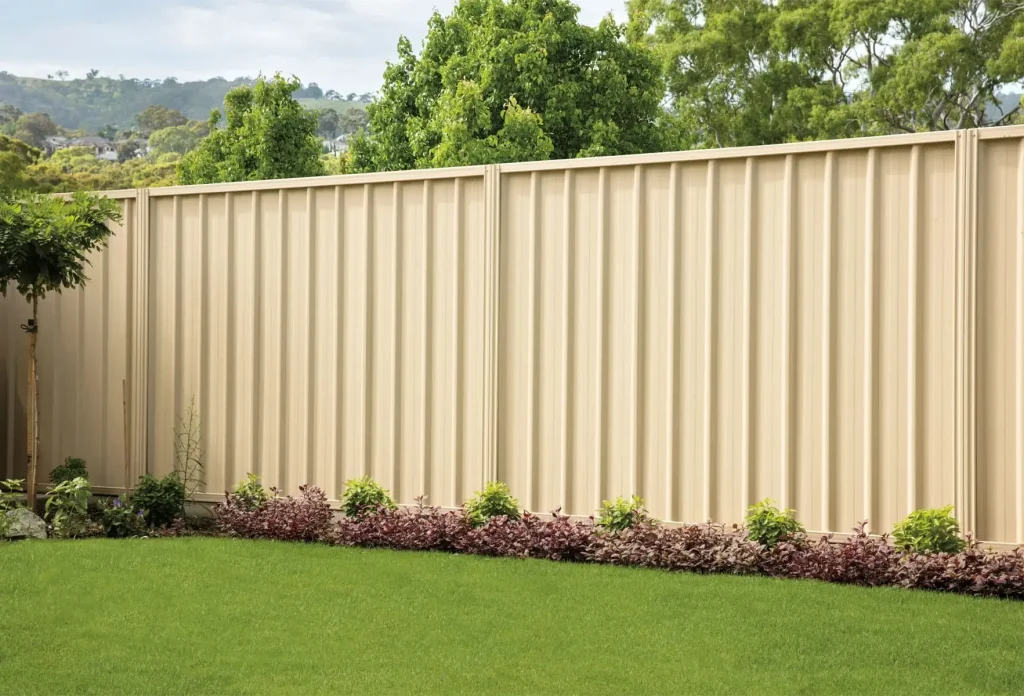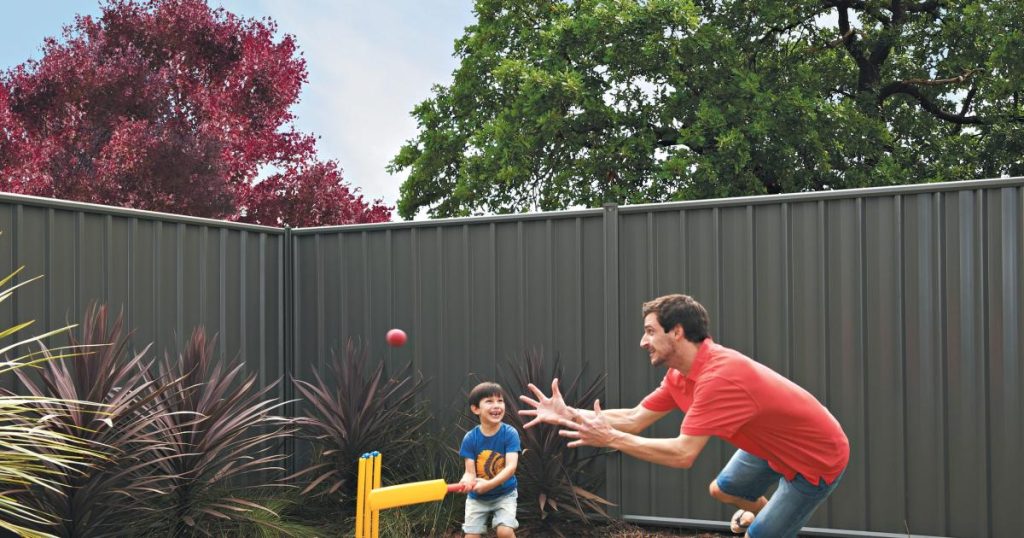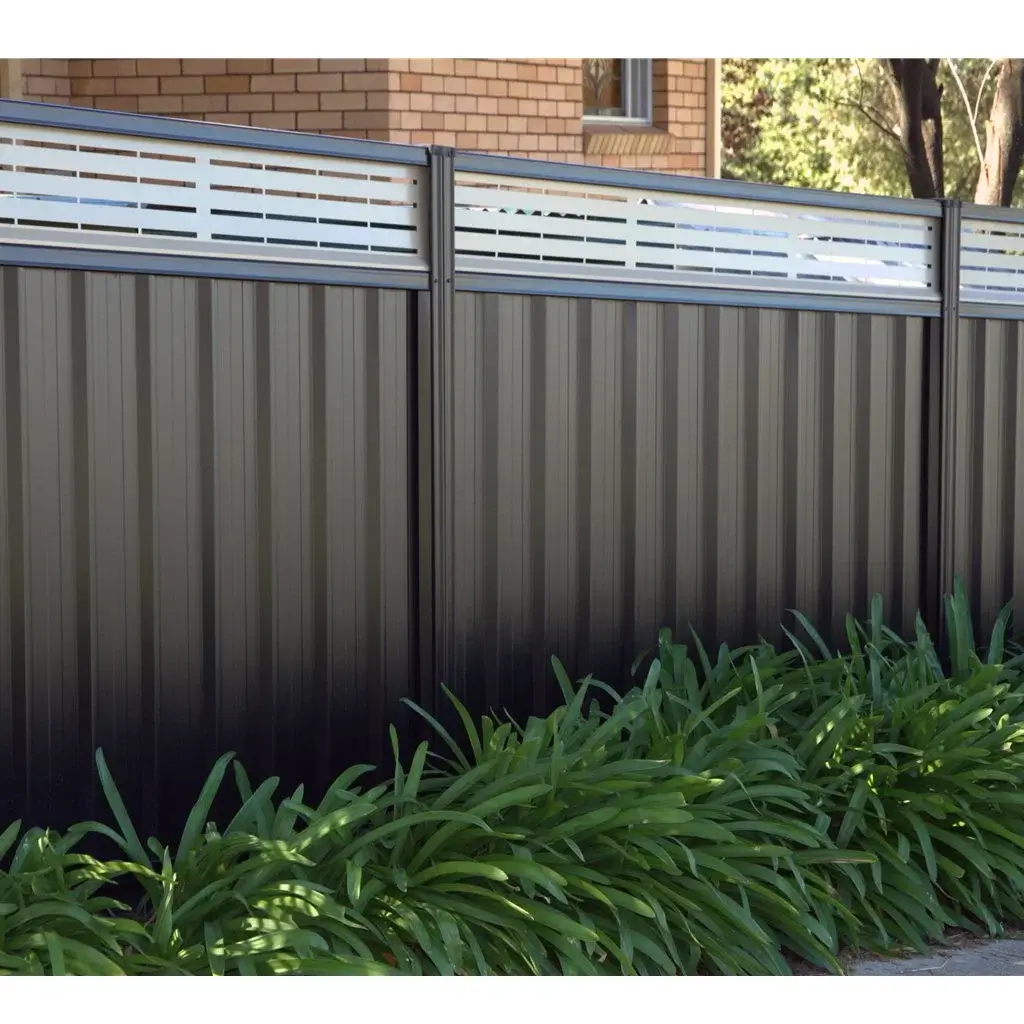
As an experienced fencing contractor serving Wollongong, I have seen firsthand how proper maintenance can extend the life and enhance the appearance of a Colorbond fence.
Here are ten essential tips to keep your Colorbond fence in top condition, ensuring it remains a durable and attractive feature of your property for years to come.
Table of Contents
- Regular Cleaning
- Preventing Soil and Water Build-Up
- Addressing Scratches and Paint Damage
- Managing Graffiti
- Avoiding Physical Damage
- Monitoring for Rust
- Handling Vegetation
- Proper Use of Detergents
- Seasonal Inspections
- Professional Help

1. Regular Cleaning of Your Colorbond Fence
Regular cleaning is the foundation of maintaining a Colorbond fence‘s appearance and durability. A clean fence not only looks great but also lasts longer by preventing dirt and debris from causing wear and tear.
Routine Maintenance:
Every two to three months, rinse the fence with a garden hose. Start at the top and work your way down to ensure dirt flows off evenly. If possible, use a gentle spray setting to avoid displacing protective coatings.
Removing Stubborn Dirt:
For built-up grime, mix warm water with a mild detergent (e.g., dishwashing liquid) and gently scrub the surface using a soft bristle brush or sponge. Rinse thoroughly with clean water to remove soap residue.
Target Problem Areas:
Focus on areas prone to dirt accumulation, such as corners, edges, and near the ground, where mud splashes might occur after rain.
Avoiding Abrasive Cleaners: Do not use harsh chemicals or abrasive materials like steel wool, as these can damage the fence’s protective paint and coating.
2. Preventing Soil and Water Build-Up
Soil and water pooling around the base of your fence can lead to long term damage, including corrosion and structural instability.
Proper Soil Management:
When gardening or landscaping, keep soil levels at least 5–10 cm below the bottom of the fence. This allows for air circulation and reduces the risk of moisture retention.
Effective Drainage:
Install drainage solutions like a gravel trench or a slight slope to direct water away from the fence. For instance, a layer of crushed rock can serve as a barrier between the soil and the fence while aiding water drainage.
After Heavy Rains:
Inspect the area after storms to ensure water is not pooling. If necessary, regrade the soil or install a French drain to manage excess water.
3. Addressing Scratches and Paint Damage
Minor scratches are inevitable but should be addressed promptly to prevent rust. Repainting the entire panel is preferable over using touch up paint, which can sometimes look patchy and uneven. Choose a high quality paint that matches your fence colour to maintain a uniform appearance.
Scratches and paint chips can expose the metal beneath, making it vulnerable to rust. Acting quickly can prevent more significant problems.
Cleaning Before Repair:
Use a damp cloth to remove dirt and grease from the scratched area. Allow it to dry thoroughly before proceeding.
Repainting Techniques:
For minor scratches, lightly sand the area to remove any rust or debris, then apply a primer followed by matching Colorbond paint. For larger areas or panels, repaint the entire section for a seamless finish.
Colour Matching:
Use the official Colorbond colour chart to find the exact shade. Most hardware stores stock touch up paints and sprays designed specifically for Colorbond products.
Sealing for Longevity:
After painting, apply a clear, weather resistant sealant to protect the repair and maintain a consistent finish.
4. Managing Graffiti
Graffiti can be a frustrating problem, but addressing it promptly can prevent it from becoming a long term issue.
Removing Graffiti:
Use graffiti removers approved for Colorbond fencing. Apply the remover as per the manufacturer’s instructions, typically using a soft cloth or sponge to avoid scratching.
Prevention:
Consider applying an anti graffiti coating to your fence. This clear layer creates a barrier that makes it easier to clean off future graffiti without damaging the surface.
Community Involvement:
Report graffiti to local councils, which may have resources to assist with removal or offer preventive measures in high risk areas.
5. Avoiding Physical Damage
Protecting your fence from dents and scratches is crucial for maintaining its structural integrity and aesthetic appeal.
Safe Storage:
Avoid leaning heavy tools, bikes, or other objects against the fence, as prolonged pressure can cause warping or dents.
Protective Barriers:
If working near the fence with equipment like wheelbarrows or trimmers, place a temporary barrier, such as plywood, to shield the fence from accidental contact.
Heavy Winds:
In windy conditions, secure loose objects like garden furniture or bins to prevent them from being blown into the fence and causing damage.
6. Monitoring for Rust
Even though Colorbond fences are rust resistant, regular checks are necessary to catch early signs of corrosion.
High Risk Areas:
Inspect screws, joints, and edges where water or dirt may accumulate. These spots are more likely to develop rust over time.
Rust Treatment:
Sand away any rust spots gently, then clean and apply a rust inhibiting primer. Finish with a coat of matching paint to restore the fence’s protective barrier.
Preventive Coatings:
Consider applying an additional weather resistant coating to enhance the fence’s durability, especially if you live in coastal or humid regions.
7. Handling Vegetation
Plants growing too close to your fence can cause damage by trapping moisture or scratching the surface.
Trimming Regularly:
Maintain at least 30 cm of clearance between your fence and surrounding vegetation. For fast growing plants like bougainvillea, frequent pruning is essential.
Choosing the Right Plants:
Opt for low maintenance plants that don’t spread aggressively, such as native grasses or small shrubs, which are less likely to encroach on your fence.
Supporting Climbers:
If you want climbing plants, use a freestanding trellis positioned at least 15–20 cm from the fence to allow airflow and prevent attachment.
8. Proper Use of Detergents
Using the right cleaning products preserves your fence’s finish and prevents unnecessary wear.
DIY Cleaning Solution:
Mix five litres of water with a small amount of mild detergent. This gentle solution is sufficient for regular cleaning without harming the protective coating.
Spot Testing:
Before using any new cleaning product, test it on a hidden part of the fence to ensure it doesn’t cause discolouration or damage.
What to Avoid:
Steer clear of bleach, harsh degreasers, or acidic cleaners. These can weaken the paint and protective layers, leading to premature wear.
9. Seasonal Inspections
Regular inspections are vital for identifying potential issues early and keeping your fence in top condition.
Inspection Checklist:
Look for loose screws, rust spots, dents, bent panels, and any paint flaking or discolouration.
After Severe Weather:
Inspect your fence after storms, hail, or high winds to identify and address damage promptly.
Tools for Repairs:
Keep basic tools like a screwdriver, rust inhibiting primer, and matching paint on hand to handle minor repairs as needed.
10. Professional Help
For extensive damage or if you’re unsure how to handle a specific issue, it’s best to consult with a professional fencing contractor. They can provide expert advice and services to restore your fence to its best condition.
Sometimes, professional assistance is the best way to maintain or restore your Colorbond fence.
When to Call a Professional:
If your fence has significant damage, such as large dents, structural misalignment, or widespread rust, seek help from a qualified fencing contractor.
What to Expect:
Professionals can provide services such as panel replacement, repainting, or even applying specialised coatings to enhance durability.
Choosing the Right Expert:
Look for contractors with experience in Colorbond products and positive customer reviews. Ask for a detailed quote and ensure they use genuine materials.

Why Choose Us for Your Fencing Needs?
Expertise: With years of experience in both residential and commercial fencing, we provide top notch service and advice.
Quality Materials: We use only the best materials to ensure durability and longevity.
Custom Solutions: We tailor our services to meet your specific needs and preferences.
Competitive Pricing: Our rates are fair and transparent, providing excellent value for your investment.
Customer Satisfaction: We prioritise your satisfaction and strive to exceed your expectations.
Contact us today for more details or to request a free quote. Let us help you keep your Colorbond fence looking great and standing strong.
FAQs
To keep your Colorbond fence looking its best and ensure its durability, clean it at least twice a year. Cleaning removes built up dirt, grime, and pollutants that can dull its finish over time. Use warm, soapy water with a soft cloth, sponge, or brush to gently scrub the surface. If your fence is near the coast or in an area with high pollution, consider cleaning it more frequently to prevent salt or residue from affecting its protective coating.
Yes, you can use high-pressure washers on your Colorbond fence, but it’s crucial to use the right settings to prevent damage. Stick to a low to moderate pressure setting—around 1,200 to 2,000 PSI is ideal. Ensure the nozzle is kept at least 30 centimetres away from the surface, and use a fan or wide-angle spray to avoid concentrating too much force on one area. Avoid harsh attachments or rotating nozzles, as they can strip the protective coating.
Scratches can expose the metal underneath the Colorbond coating, so it’s important to address them quickly to prevent rust. First, clean the area with warm, soapy water and let it dry completely. Then, apply a touch-up paint that matches the original colour of your fence. These paints are readily available from hardware stores or the manufacturer. For deeper scratches or gouges, you might need a protective sealant to ensure the damage doesn’t worsen over time.
The best way to prevent rust on your Colorbond fence is by maintaining its protective coating and keeping it clean. Remove any debris, such as leaves or branches, that can trap moisture against the surface. Avoid using abrasive tools or harsh chemicals that could damage the finish. If you notice any scratches or chips, repair them promptly with touch-up paint or sealant to prevent moisture from seeping in. Regular inspections for early signs of rust will also help you catch and fix issues before they escalate.
Graffiti can be frustrating, but it’s removable with the right approach. Use a graffiti remover or a non-abrasive cleaner specifically designed for painted metal surfaces. Before applying, test the product on a small, hidden section of the fence to ensure it doesn’t damage the finish. Apply the cleaner according to the instructions, and gently scrub with a soft cloth, sponge, or brush. Avoid using abrasive tools like steel wool, as they can scratch the surface.
Planting bushes near your Colorbond fence is fine, but proper planning and maintenance are essential. Leave a gap of at least 30 centimetres between the plants and the fence to allow for adequate airflow, which helps prevent moisture buildup and rust. Choose non-invasive plants with soft branches to minimise the risk of scratching the fence. Regular pruning will ensure that leaves, branches, and roots don’t touch the fence or cause damage over time.
You should consider professional assistance if your Colorbond fence has significant issues like deep scratches, rust, warping, or structural instability. Additionally, if a section of the fence has come loose due to strong winds or impact, professionals can safely and effectively repair it. For complex tasks like replacing damaged panels or restoring the protective coating, hiring an expert ensures that the repairs are done correctly and your warranty remains valid. Regular professional inspections can also help detect hidden issues early.
